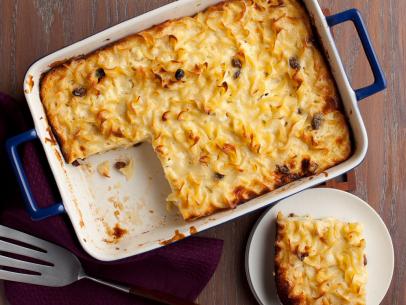
Recipe courtesy of Jason Wang
From:
Food Network Magazine
Hot Oil–Seared Biang-Biang Noodles
Getting reviews...
- Level: Intermediate
- Total: 2 hr 10 min (plus 1 hr refrigerating of biang-biang noodles)
- Active: 2 hr
- Yield: 1 serving
Walk past any of the eight Xi’an Famous Foods in New York City and you’re bound to see a crowd. The restaurants are legendary for their hand-pulled noodles, inspired by the foods of Xi’an, China, where owner Jason Wang grew up. His dad David Shi opened their first restaurant in 2005, and since then the family has introduced thousands of people to Xi’an’s dense, chewy, irresistible noodles. We asked Jason to show us how to make them at home.
- Level: Intermediate
- Total: 2 hr 10 min (plus 1 hr refrigerating of biang-biang noodles)
- Active: 2 hr
- Yield: 1 serving
Ingredients
For the XFF Noodle Sauce:
For the Noodles:
Biang-Biang Noodles:
Directions
- Make the XFF noodle sauce: In a saucepan, mix all of the ingredients with 1/4 cup of water. Bring to a boil over high heat. Reduce the heat and cook at a low boil, 2 minutes. Turn off the heat, cover the pot and let sit 10 minutes. Strain the sauce. You’ll need 1/4 cup for this recipe; refrigerate the remainder in an airtight container for up to 3 days.
- Make the noodles: Bring a large pot of water to a boil. Pull the dough into 3 noodles (see below). Throw all the noodles into the water at the same time. Stir with tongs to prevent sticking. Boil for 2 to 3 minutes; remove with tongs and set aside to drain. Cook the cabbage briefly in the noodle water. Strain out and place with the noodles.
- Meanwhile, in a small cast-iron skillet, heat the vegetable oil over high heat until just shimmering, 1 to 2 minutes.
- Combine the noodles, cabbage and 1/4 cup noodle sauce in a serving bowl (or do this in a saucepan). Place the chili powder, garlic puree, scallion, celery and chive in a little pile on top of the noodles. Carefully drizzle the hot oil over the pile of aromatics on the noodles, making sure every bit gets sizzled. Stir quickly and serve immediately.
Biang-Biang Noodles:
- Make the Dough: Knead until a dough is formed, 8 to 10 minutes, then remove the dough to a floured board and continue kneading until smooth and springy.
- Place the flour in a large bowl. Dissolve the salt in the water in a measuring cup. Add the salt water to the flour, 1/4 cup at a time, mixing with your hands.
- Clean out the bowl, then return the dough to the bowl. Cover with a moist towel and let rest 5 minutes, then knead for a minute or so on a floured board. Repeat this rest-then-knead process twice more.
- Roll Out the Dough: After the final rest and knead, flatten the dough into a rectangle to the best of your ability. Cut the dough into 3 1/2-ounce pieces (about 6).
- Use a rolling pin to roll each piece of dough into a flat rectangle, a little over 1/4 inch thick (4 to 5 inches long and 1 1/2 inches wide).
- Rub the dough with vegetable oil and place on a plate (don’t stack them on top of one another). Cover with plastic wrap and refrigerate, at least 1 hour or up to 3 days.
- Stretch the Dough: Evenly press and stretch the dough rectangles into flatter rectangles, about 6 inches long and 3 inches wide.
- Bring the dough to room temperature. Flatten on a clean counter with your hands until the dough feels stretchy and elastic. At this point you should bring your water to a boil. (See recipe above.)
- Grab the ends of a rectangle with your thumbs and forefingers. Stretch the dough gently until shoulder-width long. Pull and slap the noodle against the counter up and down until the dough is almost 4 feet long.
- Rip the Noodles: Pick up the noodle in the middle and rip it into two pieces like string cheese. Pull until you almost reach the end, but don’t pull all the way through.
- You’ll end up with a giant noodle ring. Carefully press the ends of the strands to stretch and even them out if they’re too thick. Pull and rip the remaining noodles.
Cook’s Note
Be careful not to pull the noodles too quickly or grip them too tightly or they’ll break. If a noodle does break, just grab onto the broken part and pull from there.
Looking for Something Else?
Related Pages
- Shanghai Fried Noodles Recipe
- Shanghai Stir-Fried Chunky Noodles Recipe
- Singapore-Style Noodles Recipe
- Pan-Seared Scallops with Brown Butter, Hazelnuts...
- Cold Sesame Noodles Recipe
- Orange Chile Noodles Recipe
- Huevos Tripados Peruvian Tomatoes and Egg Noodles...
- How to Make Biang-Biang Noodles From Scratch
- 5 Homemade Biang Biang Noodle Making Tips from...
































